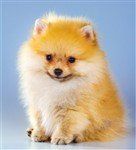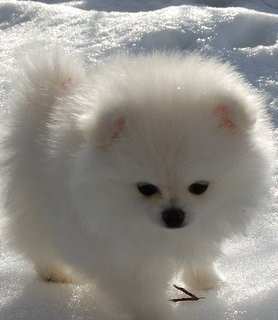White
PetPom

The
Pomeranian
Information
Center
White Pomeranians


Photo courtesy of WigglyPaws
Overview
White Pomeranians are rare. This is because there are so many other colors in the bloodline that are more dominant; one must focus purely on solid whites to produce them. And no other color must appear in the genes for at least 5 generations back.
We are going to discuss two main elements about white Pomeranians:
- Breeding
- Color Changes
- Eye and Skin Color
- How to Know Your Pom will Have a White Coat
- Caring for a White Pom
Breeding for White
Just like
Merles, producing pure white Pomeranians is not an easy task.
If one does too much breeding of whites to whites, it increases the chance of producing 'throwbacks'… Poms that are larger than the standard size.
One must slowly breed out other colors, orange being one of the strongest, and often this produces lemon shadings on the Pom, which then must be slowly bred out.
For a Pomeranian to be officially white, per AKC standards, they must be free of any lemon or other colors. There are other shadings that may appear as well; Too often, a cream Pom is registered as white when they should not be.
The Chinchilla gene makes the ice white Pomeranians possible. By using wolf sable and cream sable dogs, this often crosses out those colors and helps to produce whites. One must also strongly keep in mind the quality of the coat, which must be preserved through breeding…wolf sable will help to lighten the coat while keeping that coat high quality.

-min-198x350-1920w.jpg)
Cotton (aptly named), photo courtesy of Penny Macias
Cotton (aptly named),
photo courtesy of Penny Macias
Color Changeswith White Coats
Color Changes with White Coats
One must be aware of color changes. The most important thing to know is that a cream Pom and
partis most often appear to be a white Pomeranian at birth. Those without experience, when seeing these newborns will assume that the puppy is white.
However, color changes often occur and the dogs will not stay white.
Generally, by the age of 8-12 weeks, one will know if the white Pomeranian is to stay that color.
You can do so by looking closely at the color behind the ears of the puppy. If there is any cream, very pale orange
or lemon…any shading at all, this will not be an official white Pomeranian.


Chanel, a gorgeous white parti-Pom
Notice the white heart shape on her forehead
Photo courtesy of owner: Lisa Canavan
You can also often see these colors in the hock region or behind the ears. Any shading and you will have a cream Pom, a very diluted orange or other, but not pure white.
These very faint colors most often, during the coat change from puppy to adult, will intensify in color. Once the “puppy uglies” stage is done, the Pom will be either cream, orange or whatever pale shading showed as a pup.
Even a small patch of another color can become large; a white Pom with a tiny patch could mature into a parti (2 colored coat).
All Poms go through color changes during this phase, therefore it is not just the white Pomeranian.
While each dog is individual, most often a dark pup will have a lighter adult coat and a light puppy will have a darker adult coat.
Since a puppy is normally sold at the age of 8 weeks old, one cannot be certain what color that Pomeranian will be as an adult.
A reputable breeder will do their best to make an educated guess and that will be the color listed on the pup’s registration. It is very common for the registration to show a color that is completely different than the adult dog’s coat color.
In fact, Poms change colors so quickly, that a breeder is allowed to change the color on the registration multiple times.
Eye and Skin Color
The typical
eye coloring for pure white Pomeranians is dark eyes (very dark brown or black) with black skin (eye rims, nose, lips and paw pads).
If a white Pom were actually a white parti, meaning that there is a secondary color, and that 2nd color was blue, chocolate or other self-coloring coats, the skin could be blue or liver.
And with those Poms, there is a possibility that the eyes would be lighter (light brown, hazel) or even blue (though blue is not accepted by the AKC).
See also:
Nose Colors of the Pomeranian.


Bunny
Photo courtesy of owner: Liz Friedland
How to Know You Are Getting a Pure White Pomeranian
Your best bet is to obtain a puppy from a breeder that specializes in white. This way, there will be fewer suprises.
In regard to breeders that focus on other colors too, while the aim will be for white, if other colors are in the bloodline and skip one or more generations, there is always the chance that a white Pom will not remain pure white.
However, as stated above, any shadings of other colors , especially behind the ears, is a good sign that the Pom will NOT be white.
It is best if you also:
Ask to see the sire and dam (parents) of the puppy. It is best to see the parents in person. Photos can be extremely misleading (or in cases of unethical breeders, they can be touched up with PhotoShop).
If a breeder has the ability to produce whites, they certainly should be able to show you, in person, some of their white dogs.
If you are purchasing a puppy over the Internet, be aware that there is something amiss if you see white Pomeranian puppies on the site, but no adults of that color.
If you are looking for a Pomeranian of this wonderful color, you may wish to look at our exclusive list of Personally Recommended Breeders.
Care for a White Pomeranian
There's a few elements that you'll want to pay more attention to:
1)
With this coat color, tear staining will be more obvious that with just about any other coat.
Careful wiping of the face with a quality canine wipe, offering only filtered water, and using a quality tear stain product like Eye Envy Tear Stain Remover for Dogs
 will help keep the hairs around the eyes from becoming discolored.
will help keep the hairs around the eyes from becoming discolored.
2)
Long fur hanging from the ankles down to the paws will pick up dirt and debris and on a white Pom this will be exceedingly obvious.
It can really help to trim the lower legs and around the paws to keep the coat nice and tidy and dirt free.


Casper, 6 months old
Photo courtesy of owner: Jaime Ross
3)
After walking outside, take a moment to wipe the paws and lower legs with a canine wipe. Keeping a box near the front door can make this quick and easy.
If you email photos to us, you agree that PetPom is given free copyright to use at our discretion. We will always credit the photo to the name of the Pom's owner(s) if it is supplied.
Email: Contact@PetPom.com
All text, images and artwork protected by US and International copyright laws. All rights reserved. Copyright PetPom.com
We are a participant in the Amazon Services LLC Associates Program, an affiliate advertising program designed to provide a means for us to earn fees by linking to Amazon.com and affiliated sites.
